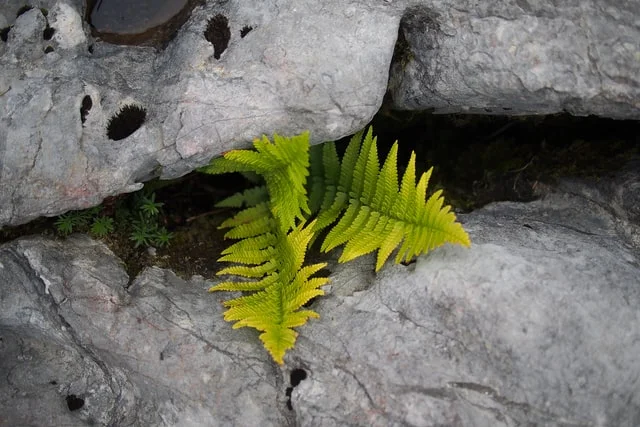The asparagus fern is a beautiful species in the lily family. It can be grown indoors and outdoors with fairly minimal care levels.
This species resembles fern plants but has needles instead of leaves. It produces whitish-green flowers that turn into purple-red berries. While the type of plant is resilient when it is healthy, there are occasions when it may start to turn yellow.
Read more: Asparagus Fern Care – A Complete Guide
Table of Contents
Most Common Reasons for an Asparagus Fern Turning Yellow
An asparagus fern turning yellow may be an indication of several issues, most of which can be resolved as long as the problems are treated quickly. With each diagnosis, there tend to be other indications, helping you to find and treat the correct problem.
Overwatering
One of the most common causes of an asparagus fern turning yellow is overwatering. This yellowing happens because the roots sit in the water for an extended period, causing damage to the roots. The damage results in the foliage becoming discolored.
Overwatering may happen in a few different ways. Adding too much water or adding it too frequently is one method. However, poor-draining soil mix or using a pot with inadequate draining could be the culprits as well.
To find out if this is the issue, you are advised to check the soil and the pot for excessive moisture. You can check the roots as well.
They may have a yellow tinge to them. If they have turned brown or black and softened, the additional moisture has caused a fungal issue, possibly root rot. A foul odor may also be present.
To fix this issue, repotting in fresh soil in a new pot is necessary. Damaged portions must be trimmed near the soil using sharp, sterile pruning shears.
Read more: Asparagus Fern Propagation
Underwatering
These plants are usually resistant to drought. However, if the foliage is inconsistently watered, or it has gone without water for an extended period, the asparagus fern turning yellow is common.
To distinguish this from other causes, the needles and stems may start to turn brown as well. These areas will begin to feel crispy due to dehydration, and the soil will be very dry.
Even if the plant has been watered consistently, other factors could cause the soil to dry and the plant to become dehydrated. These variables include high temperatures, low humidity levels, and if the plant is potbound.
To address this issue, the damaged areas need to be removed. These areas typically do not recover even after the plant is watered. However, new growth will start to form after moisture has been added.
Low Lighting
This factor is another of the most common causes of an asparagus fern turning yellow. The issue is usually a slow-developing one. as the plant will try hard to survive on the lower levels of lighting.
Other than the yellowing, other signs include the fronds becoming stretched and sparse in needles.
One method to check if the lighting is sufficient is to look at the shadow. You can place your hand in the light. If the shadow is clear, the light is adequate. If the outline is fuzzy or if there is no outline, there is not enough light.
Asparagus fern plants tend to recover from this particular issue rather well when they are placed in a location with more light.
Depending on the lighting conditions throughout the day, the plant may need to be moved around to different areas to obtain adequate amounts.
Too Much Light
Too much light can cause the fern to scorch, thus causing it to turn yellow. This issue can be caused with as little as between one and two hours of hot direct sunlight per day.
To fix this issue, the plant needs to be moved to a location with indirect sunlight. You must wait for new growth to appear before pruning the damaged areas.
Pest Problems
Several types of insects and infestations cause the asparagus fern to turn yellow. This list includes mealybugs, scale, spider mites, aphids, and thrips.
Each of these feeds off of the plant, which causes malnourishment. The result is patchy yellowing of the foliage. Upon inspection, these insects are visible.
Damaged plant areas must be removed. The treatment may vary based on the insect infestation. Insecticidal soaps or neem oil may offer a solution, but other treatments specifically for the type of plant and insect are often available.
Frequently Asked Questions
Why are my asparagus ferns turning yellow?
Several factors can cause this plant to turn yellow. These reasons include overwatering, underwatering, inadequate lighting, too much light, and certain types of insects.
Aside from the yellowing, each has additional symptoms to check for to ensure the correct diagnosis.
Can yellow leaves turn back to green?
Yellowed leaves, needles, or fronds rarely ever return to their green color. Instead, you are recommended to prune off the damaged areas by cutting close to the soil.
These pruned areas will produce new growths to replace the removed damaged parts. Because the plants are fast-growers, the new growths should not take long to appear.
Should you cut back asparagus ferns?
While regular pruning is not required for this species, it is advised to be done when there is damage to the plant. This process should be completed using sharp, sterilized pruning shears or scissors.
The cuts must be made at the points closest to the soil’s surface. New growths will develop in these areas to replace those that have been removed.
Why is my asparagus dying?
There could be several reasons for an asparagus fern dying. When certain issues, such as overwatering, underwatering, low lighting, scorching, and pest problems, become too severe, they can cause fatal damage.
To prevent the actual death of the plant, the diagnosed issue should be treated immediately, removing the damaged areas.
How do you revive a dying asparagus fern?
Reviving a dying asparagus fern depends on the factor that caused the damage. The advised route is to ensure that the plant is receiving the proper amounts of light and water while looking for and treating any pest issues.
Fertilizing the plant may help revive the foliage as well.
Photo by Nick Grappone on Unsplash



